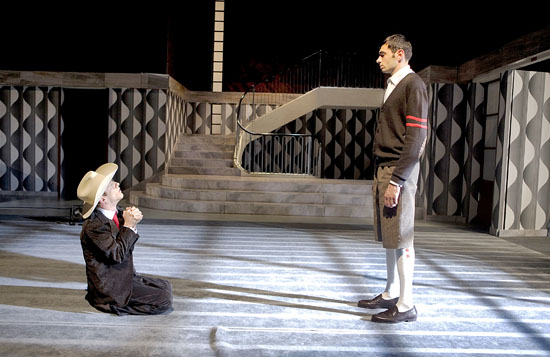Have you done anything sinful lately? If so, a trip to UCLA Live’s production of “Purgatorio,” a presentation of a modern purgatory, promises to offer both an examination of sins and a chance for redemption.
“Purgatorio,” coproduced by UCLA Live, is the second piece in its Eighth International Theatre Festival.
The play, currently showing at the Freud Playhouse until Oct. 31, is based on medieval Italian poet Dante Alighieri’s epic poem, “The Divine Comedy,” particularly the second cantica, “Purgatorio.”
The play was originally presented in Europe by Italian theatrical company Societas Raffaello Sanzio as part of a modern “Divine Comedy”-inspired trilogy. “Purgatorio,” the second piece in the trilogy, is the only one that will be presented to American audiences.
Director Romeo Castellucci revealed the reason he chose Dante as his source of inspiration ”“ the poem’s importance within the Italian culture.
“People in Italy read (“The Divine Comedy”) to their children, so in a sense it represents people and it represents an encounter and a challenge that is impossible to avoid,” Castellucci said through an interpreter.
Third-year Italian studies doctoral student Christopher White said he finds that the challenges encountered within “The Divine Comedy” make it still relevant today, despite it having been written in the 14th century.
“(There are) themes in the idea of somebody who is lost, in the cliched term of a mid-life crisis, but who is trying to find himself and learn,” White said. “So I think for anybody, a journey like that is still relevant.”
Similar to Dante, Castellucci’s reimagining of “Purgatorio” also contains a spiritual journey from sin to forgiveness, though this time the process of rejuvenation is taken by a family rather than a single character.
“I needed to find a structure that was simple and commonly found within society, so I chose family: the mother, the father and the child,” Castellucci said. “The main focus is the relationship between the father and child.”
Yet Castellucci emphasizes the importance of audience perception within the play by offering multiple interpretations of the father-son relationship and letting viewers choose their own explanation.
“There are many ways of reading the relationship,” Castellucci said. “It can be a social reading, it can be a psychoanalytical reading, even a Biblical reading because the relationship between the father and the child is always marked by violence and love.”
Despite the fact that Castellucci’s “Purgatorio” is different in locale and story than Dante’s, both are similar in that they are trying to find their own definition of what constitutes Purgatory.
“”˜Purgatorio’ is interesting because Dante, he was different from what the Catholic Church interpreted as Purgatory and went off into his own definition of Purgatory,” White said.
For Castellucci, the piece is also an exploration of a different type of Purgatory that has not been seen before ““ not even by Dante.
“It’s sort of a treatise on what Purgatorio means to him,” said David Sefton, UCLA Live artistic director. “Castellucci is setting out to create a sense of the most horrendous and unimaginable thing that he can come up with.”
Sefton, who had previously invited Castellucci to UCLA in 2002, had always been a fan of the latter’s work. To him, “Purgatorio” is something unlike anything that has been seen before in the theatrical world.
“Castellucci is utterly, utterly original,” Sefton said. “His use of visuals, the stage and the sound ““ in “˜Purgatorio’ in particular, how time rolls out in the piece is very disjointed. The whole thing is a completely unique theatrical language.”
In contrast to this assessment, Castellucci does not find his version of “Purgatorio” as radical. Instead, he attributes its aspects to classical Greek tragedy, which does not provide any answers to the audience, only questions.
Particularly in “Purgatorio,” the questions he poses have their basis in the human condition.
“What does it means to be human? What defines us as human? It’s the same problem that faces us after 3,000 years, like hunger and thirst,” Castellucci said.
Because UCLA Live was one of the coproducers of “Purgatorio,” there was always an intention to bring the play to the United States, particularly to Los Angeles.
“The play (is) absolutely perfect for an American audience,” Castellucci said. “There are also many references to cinema and to film (in the play,) so what city better than Los Angeles?”
“Purgatorio” will be playing its sole U.S. engagement at UCLA, after which the piece will head to Tokyo where it will finish its run.
As a result, this is the only time that American audiences will be able to see what Sefton said he considers to be “the most powerful piece of theater I’d have put on this stage in 10 years of being in Los Angeles.”
“It’s definitely not easy to watch ““ and it’s not meant to be ““ and it’s intense, but it is an unforgettable and profound piece of theater,” Sefton said.
